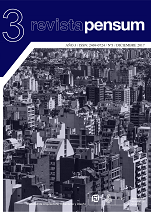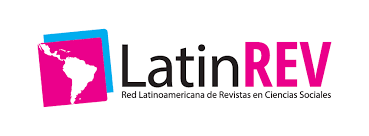CONCEPTUAL ARCHITECTURE CONNECTIONS BEYWEEN THE ANALYTICAL TWIST OF RECENT ART AND PROJECT RESEARCH
DOI:
https://doi.org/10.59047/2469.0724.v3.n3.19017Keywords:
Project Research, Self, Awareness, Conceptual Art, Conceptual ArchitectureAbstract
Architecture understood as art or knowledge - tejné - has its origins in an ancient complex that today refers to the transdisciplinary. It is from this context that we try to dive into the project as a problem in view of the specificity of its connection with recent art. This issue arise in the context of the research of the Doctoral Thesis currently being performed by its author in the Doctorate in Architecture department in the Faculty of Architecture, Urban Planning and Design (FAUD), National University of Córdoba (UNC): "Project research and cutting edge art. Connections between the analytical twist of recent art and architecture as cultural practice". This paper attempts to develop some points of that complex discussion, taking into account the project practice and its relationship with the field of art, in its more critical and self conscious face, where its genealogies lie on the avant garde, the analytical philosophy and even science. This means raising at least a level of suspicion on that project production which does not give rise to self-criticism. Some dialogues should then be recognised and reviewed in the context of the so-called analytical twist of art that took place in the second half of the twentieth century and a way to conceive the architectural project as a cultural practice. A device that builds knowledge for and from discipline/knowledge: the project as researchDownloads
References
Bachelord, D. (1999) Minimalismo. Serie Tate Gallery. Millbank, Londres: Encuentro Ediciones.
Cauquelin, A. (2016) Las teorías del arte. CABA, Argentina: Adriana Hidalgo Editora.
Correal P., G. D. (2007) El proyecto de arquitectura como forma de producción de conocimiento: hacia la investigación proyectual. Revista de Arquitectura, vol. 9, pp. 48-58.
Recuperado de: http://www.redalyc.org/articulo.oa?id=125112650010
Davison, C. (2006). Tras el rastro de Eisenman. Ed. Akal.
Eisenman, P. (1971) Appunti sull architettura concettuale. Verso una definizione. Casabella Nº 359-360, Año 35.
(1967) Cardboard Architecture: House I. Five architects, pp.15-22. Recuperado de:
García-Yévenes, y Gracia Gil (2003) Huellas y De-simetrías. Espacios entramados en la Discontinuidad. [Tesis doctoral]. Universitat Politècnica de València. Recuperado de: http://hdl.handle.net/10251/2662
Guasch, A. M. (2009) El arte último del siglo XX. Del posminimalismo a lo multicultural. Madrid, España: Ed. Alianza Forma.
Krauss, R.(2009) La originalidad de las vanguardias y otros mitos modernos. Madrid, España: Ed. Alianza Forma.
Lacasta, M. (2013) Una aproximación a un joven Eisenman.
Recuperado de: https://axonometrica.wordpress.com/2013/02/18/una-aproximacion-a-un-joven-eisenman/
Lippard, L. (2004) Seis años: la desmaterialización del objeto artístico 1966 a 1972. Madrid, España: Ed. Akal.
Lorenzo-Eiroa, P. (2008) Instalaciones: sobre el trabajo de Peter Eisenman. Buenos Aires, Argentina: Ed. Robles.
Montaner, J. M. (2015) Del diagrama a las experiencias, hacia una arquitectura de la acción (1era ed.) Barcelona, Madrid: Ed. Gustavo Gili.
(2010) Arqueologías de los diagramas. Cuadernos de proyectos arquitectónicos,vol.1. p.p. 16-20 Recuperado
de: http://polired.upm.es/index.php/proyectos_arquitectonicos/article/view/132/131
Osborne, P. (2006) Arte Conceptual. Barcelona, España: Ed. Phaidon.
Perez Carreño, F. (2003) Arte Minimal. Objeto y sentido. Madrid, España: Ed. La Balsa de la Medusa.
Sarquis, J. (2003) Itinerarios del proyecto. La investigación proyectual como forma de conocimiento en arquitectura. Buenos Aires, Argentina: Ed. Nobuko.
Tatarkiewicz, W. (1987), Historias de seis ideas. Arte, belleza, forma creatividad, mimesis, experiencia estética. Ed. Tecnos.
Williams, R. (1994) Sociología de la cultura. Buenos Aires, Argentina: Ed. Paidós.
Referencia de imágenes
Figura 1- APRAF Berlín: Sol Le Witt, 1928 – 2007. (n.d.).
Recuperada de: http://www.adrianpiper.com/art/sol.shtml
Figura 2-a Gallery of AD Classics: House VI / Peter Eisenman - 3. (n.d.).
Recuperada de: http://www.archdaily.com/63267/ad-classics-house-vi-petereisenman/5037e0e128ba0d599b00018d-ad-classics-house-vi-peter-eisenman-photo
-b Interactivité: House VI. (n. d.).
Recuperado de: http://house6.s-trefois.be/data/textes/eisenman/images/eisenman/houseIV01.html
Figura 3- Eisenman House I c.jpg (n. d.).
Recuperada de http://4.bp.blogspot.com/-
bAFk6ys3pLg/TZLDoxXQrOI/AAAAAAAAADE/CVCRx7XDuf0/s1600/eisenman+house+IVc.jpg
REVISTA PENSUM | VOLUMEN 3 | NOVIEMBRE 2017 | PP. 40 / 52
Figura 4- 20Minutos. (n.d.). La banalidad de Warhol pervive en los artistas contemporáneos - 20minutos.es.
Recuperada de: http://www.20minutos.es/noticia/1535904/0/andy-warhol/banalidad/arte-contemporaneo/
Figura 5- MoMA | Sol LeWitt. Serial Project, I (ABCD). 1966. (n.d.).
Recuperada de: https://www.moma.org/learn/moma_learning/sol-lewitt-serial-project-i-abcd-1966
Figura 6- Gallery of Eisenman’s Evolution: Architecture, Syntax, and New Subjectivity - 7. (n.d.)
Downloads
Published
How to Cite
Issue
Section
License
Authors who publish in this journal agree to the following terms:
a. Authors retain copyright and guarantee to the journal the right to be the first publication of the work as well as licensed under a Creative Commons Attribution-ShareAlike 4 license.
b. Authors may separately establish additional agreements for non-exclusive distribution of the version of the work published in the journal (e.g., placing it in an institutional repository or publishing it in a book), with an acknowledgement of its initial publication in this journal.
c. Authors are permitted and encouraged to disseminate their work electronically (e.g., in institutional repositories or on their own website) before and during the submission process, as this may result in productive exchanges, as well as earlier and greater citation of published work (See The Effect of Open Access).
d. 4.0 International Creative Commons Attribution-ShareAlike 4.0 License.












